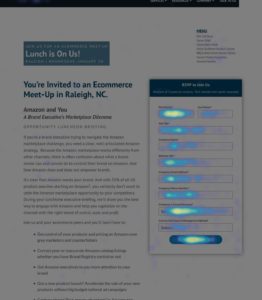You know your site could be improved, and you know that improving it can increase your website conversion rate. But you don’t have the traffic, time, or resources to do A/B testing. Where do you start? What can be done to improve the user experience on your site?
There are myriad ways to gather information about how users are engaging with your site, but the most useful and common are heuristic evaluations, user testing, and heatmaps. We have broken down how to think about (and perform) each of these in order to find quick wins that can improve your website conversion rate.
Heuristic Evaluations
Heuristic analysis is one of the best places to start when looking to improve your website conversion rate. At its most elementary level, this analysis begins with the basic rules that govern how websites should appear and function, and determines how your site stacks up against those rules.
Think of it like this: you are a user of websites. You know what to expect from websites. You should be able to walk through your site and identify any pain points that your customers may consider.
The key principle to remember is to take a step back from your personal subject matter expertise and familiarity with your own site. If you put yourself in the mindset of an average user (and lets be honest – swallow your pride a bit), you will likely find numerous areas that can be improved on your site.
While doing this analysis, try to think about your site as if it was the first time you were seeing it. Think of it through the lens of a consumer.
Start with a basic walk through of your site. Start from the homepage and make your way to the final goal completion. Were you able to do it? Did anything take you away from the final goal; did anything confuse you? These are great areas to start with when looking for optimization opportunities.
To get a deeper dive, review your website section by section–Homepage, Category Pages, Navigation & Site Search, etc.–and look at all aspects of page design and workflow. Look for anything that might cause confusion, be unclear, that does not fit, or could be done better. Lastly, but possibly most importantly, perform heuristic analysis on both the desktop and mobile versions of your site!
User behavior patterns can vary widely between device types.
There are plenty of ways to evaluate a site heuristically. If you’d like a solid starting point for your analysis, request ROI Revolution’s 30-Point CRO Checklist.
User Testing
While doing your own heuristic analysis, you must attempt to view your site “through the eyes of your user.” But with User Testing, you truly can see your site through the eyes and actions of your user base. The essence of User Testing is to have an individual (who is not familiar with your site) attempt to complete a task such as trying to purchase a product, performing research, or completing a form.
Use a tool like TryMyUI or UserTesting to administer these user tests remotely.
You typically only need three to five users to surface 90% of the pain points your site has. Nielsen Norman Group states that after this point, you will see diminishing returns on each additional user because you will start seeing the same problems again and again.
When considering how to set up your user testing, look to balance simplicity with comprehensiveness when developing your scenarios. The scenario should be comprehensive enough to cover all of the tasks and touchpoints that a user could encounter on your site.
For example, on an ecommerce site, the tasks should get the user through the typical checkout funnel from beginning to end. Try to get users to interact with the site search, the menu, product pages, product listings pages. You can also look to get users to complete micro-conversions like e-mail signups and interacting with store locators. Each user test session will take place over a finite period of time – usually around 20 minutes – so be cognizant of this when developing your scenarios.
Steve Krug, user testing expert and author of Rocket Surgery Made Easy, always suggests that if you can get a professional to do user testing for you, do it. But if you’re looking to do this work yourself, he also has a great basic user testing outline that you can personalize to fit your needs.
Heat Maps
Heat maps show how users interact with the site. They are different than site analytics event tracking because they visually represent the areas that people are clicking, browsing or interacting, not just the numbers behind the clicks. Heat Maps can also give you a better idea of how users are interacting with the whole page. Two excellent tools for gathering this data are Hotjar and Crazy Egg.
There are three kinds of heat maps: click maps, hover maps, and scroll maps. The way to read these is the same across all of the types. The colors run on a scale of gray (little to no interaction) to red (high levels of interaction). The warmer the color (red, orange, yellow), the more interaction that area gets.
Click Maps

Click maps show what users are clicking on. This kind of heat map can give visibility into whether your users are clicking on the page elements that you want them to click on.
Questions to ask yourself when looking at a click map:
- Are users clicking on a item that will not get them to the next step in the checkout process?
- Are users getting distracted by certain page elements?
- Are there too many options?
- Are there page elements that are never interacted with that could be removed?
- Are any elements below the fold, or further down the page, getting significant user interaction? If so, could they be moved higher on the page?
To take your click map analysis a step further, cross-reference your findings with event tracking in your analytics platform. For the red/yellow/orange areas in the click map, how well do users convert if they interact with these elements?
 Hover Maps
Hover Maps
Hover maps track mouse movements on a page. These reports are only available for the desktop view of your site, for obvious reasons. The great thing about hover maps is that users have a tendency to move their mouse where their eyes go. User tend to follow text with their mouse while reading, and will place the mouse pointer on images that might have zoom, or page elements that scroll when hovered on. These hover maps are great to see how users are engaging with content on the page.
Most of the questions you consider in click map analysis should also be asked when analyzing hover amps.
Scroll Maps
 Scroll maps tell you how far down the page a user scrolled. This type of report can tell you if users are getting to the most important content on the page or not. It is helpful to use this analysis in conjunction with click maps, hover maps, and event tracking.
Scroll maps tell you how far down the page a user scrolled. This type of report can tell you if users are getting to the most important content on the page or not. It is helpful to use this analysis in conjunction with click maps, hover maps, and event tracking.
Here is an example.
Say you are analyzing your scroll map. You notice that only 36% of users are getting to an area of the page that has a video. This video has a lot of users hovering over it, and a lot of users clicking on it. In previous event tracking analysis, you’ve already determined that users that watch this video have a higher website conversion rate than users who do not watch this video.
Based on the scroll map data that shows only 36% of users scroll far enough to find the video, you should try to move the video higher on the page in order to expose more users to this conversion-boosting interaction.
Start Improving Your Website Conversion Rate Today!
Analyze your site in as many ways as possible. Try to gather as much user interaction information as you can. Even if you don’t have the traffic, time, or resources to do classic A/B optimization tests, objective site analysis and user analysis can expose the gaps, pain points, and conversion boosters in your user experience. If you’re looking more specifically into optimizing your mobile website conversion rate, here are three tips to improve your mobile user experience.



 Hover Maps
Hover Maps
